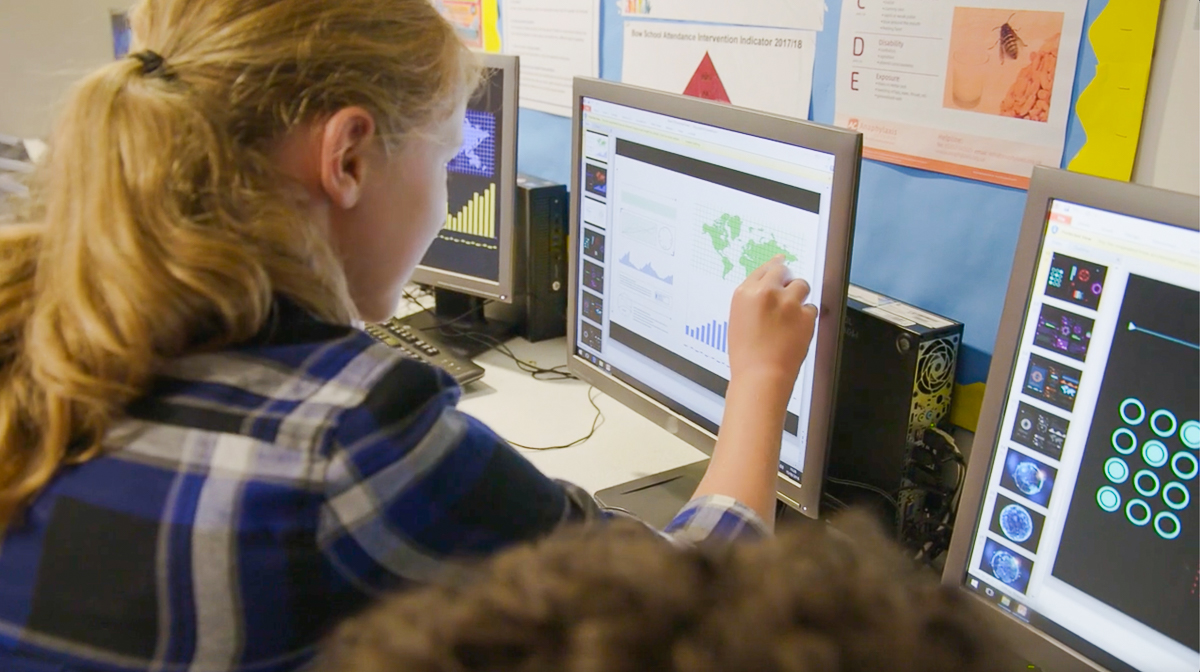Data Sense Is Essential in an Age of AI

These days, the rise of artificial intelligence (AI) is prompting profound questions about the future of work and the skills we’ll need to find and keep a job. Young people entering the job market may feel particularly anxious as job requirements shift within a changing technological and economic landscape.
Amidst this uncertainty, building skills in science, technology, engineering, and mathematics (STEM) fields remains a pretty safe bet for the future. And within STEM, needs for people in data science and AI are particularly robust and growing.1
But even if we don’t become PhD-level data scientists or AI researchers, we’ll all be better off in a world of data and AI if we develop solid foundations in data literacy and also AI literacy.
- Experts and thinkers from statistics, education, business, technology, and other fields suggest that data literacy involves understanding how to interpret, evaluate, work with, and communicate with data in ethical ways.2,3,4,5 Although definitions of data vary, I like to think of data as pieces of information that we observe, define, collect, categorize, and count to make sense of the world.
- Writers from a similar array of fields suggest that AI literacy involves a basic understanding of how AI tools work, how to use these tools ethically, and how to assess their outputs critically.6,7 Examples of AI outputs include text, images, sound, statistical figures, and programming code that can emerge from generative AI tools such as ChatGPT.8
Notably, because AI is fueled by massive amounts of data,9 many experts argue that AI literacy builds on core understandings from data science.10
To my mind, a fundamental ingredient underlying both types of literacies is what I might call basic data sense. A component of what others have called data acumen and being data savvy, data sense may be the ability to detect the strengths and limitations of the data we confront—including information generated by AI. Like a pair of antennae, data sense issues an alert when information seems wrong, or it gives an “OK, proceed” signal when information passes muster.
When people can mislead with data and AI chatbots can generate outright lies, data sense may be an essential capacity to keep our perceptions of the world from going astray.
Data sense isn’t a natural-born ability; instead, it is learned and honed through continual practice. In school, ways to build data sense may start by engaging in the systematic process and the constant questioning that’s involved when working with quantitative data and statistics. Ideally, students would have recurring opportunities throughout their K–12 years to both participate in the following four key data investigation activities and habitually ask the listed relevant types of questions:
- Formulate questions that can be investigated with data.
- What is the question asking, and why is it being asked?
- Who asked this question, and whose interests are served by the answer?
- Collect or assemble data.
- Who collected the data, and what methods did they use?
- What information did they gather, and what information did they omit?
- From whom did they collect the data? Who is included, and who is excluded?
- What broader population can the sample truly represent, and what biases may the sample reflect?
- Analyze data.
- What tools and methods were used to identify and depict data patterns?
- What are the limitations of these tools and methods, and have they been acknowledged?
- How accurate are the results and the ways they’ve been reported or represented visually?
- What levels of confidence can we have in the data results based on sample sizes and methods of data collection?
- Interpret results and summarize conclusions.
- What claims are made from the data, and how well are they supported?
- Have investigations been conducted in ways that allow claims of causation, or only correlation?
- Have people considered and used data to rebut alternative explanations of data findings?
Although education leaders across disciplines recognize the importance of building students’ data sense and data science practices, most teachers, unfortunately, have not been prepared to support these activities.11
In response, the Data Paths project, funded by the State of Massachusetts, has been developing resources to help K–12 students in the state build both data sense and important data literacy skills. The project is also helping learners gain awareness of pathways to data-intensive careers—including those involving AI.
Because school calendars are packed, we know it’s difficult to add new courses that reach all students. The Data Paths project is therefore taking the approach of helping teachers integrate fundamental data practices into their existing curricula and across multiple disciplines. We’re also developing a variety of resources for students, school counselors, and job seekers. Here’s what we’ve completed and are in the process of producing:
- A standards crosswalk that maps core data literacy skills to common K–12 standards in mathematics, science, and computer science. This tool will help teachers identify data practices that may be relatively easy to integrate into their existing instruction, while helping to meet content and practice standards in their discipline.
- Two-week-long curriculum modules for high school biology, chemistry, and physics, as well as for middle-grades mathematics. These modules support students in using real-world datasets to investigate topics such as invasive species and their effects on ecosystems, the effects of changing carbon levels in the atmosphere, the search for habitable exoplanets, and characteristics of successful crowdfunding projects.
- Sets of short instructional routines that mathematics teachers of grades 4–8 can use to integrate important data practices into their teaching throughout the year.
- An online Career Hub for students, guidance counselors, and data science job seekers, featuring a variety of resources about data-intensive occupations. Soon, we’ll add a database of programs that provide data analytics and data science-related credentials in the state of Massachusetts to the Hub.
- Webinars that spotlight data scientists and professionals in AI discussing their work and the career paths they have followed. View current webinars here.
We’re developing these opportunities and resources for teachers and students in Massachusetts, but our materials and information are freely available to educators and learners everywhere. If you’re a teacher and you’d like to find ways to integrate more data practices into your teaching, check out our materials online or contact us at datapaths@edc.org. Tell us what materials you think will work in your classroom, or what else we or others in the field can do to meet your needs.
If you’re a student and you wish to learn more about data-intensive careers, check out our Career Hub. Let us know what’s helpful and what you’d like to see that’s missing. It’s unsettling when no one really knows what a world permeated by data and AI will bring. But building basic data sense and learning about work with data and AI will be smart ways to prepare for a future that is becoming more data- and AI-driven.
Related Resources
For more information, please see the following resources:
- What Do Professional Software Developers Need to Know to Succeed in an Age of Artificial Intelligence?
- Critical Data Literacy: Creating a More Just World with Data
1Leopold, T. (2025). Future of jobs report 2025: The jobs of the future – and the skills you need to get them. World Economic Forum. https://www.weforum.org/stories/2025/01/future-of-jobs-report-2025-jobs-of-the-future-and-the-skills-you-need-to-get-them/
2Gould, R. (2017). Data literacy is statistical literacy. Statistics Education Research Journal, 16(1), 22–25. https://iase-web.org/documents/SERJ/SERJ16(1)_Gould.pdf
3Bland, S. (2025, May 8). Data literacy is an essential skill. Let’s teach it that way. Education Week. https://www.edweek.org/teaching-learning/opinion-data-literacy-is-an-essential-skill-lets-teach-it-that-way/2025/05
4Marr, B. (2022, September 28). The importance of data literacy and data storytelling. Forbes. https://www.forbes.com/sites/bernardmarr/2022/09/28/the-importance-of-data-literacy-and-data-storytelling/
5Stanke, L. (2024, January 30). The essential link between data literacy and data ethics. Data Leadership Collaborative. https://www.dataleadershipcollaborative.com/data-culture/essential-link-between-data-literacy-and-data-ethics
6Lee K., Mills, K., Ruiz, P., Coenraad, M., Fusco, J., Roschelle, J., & Weisgrau, J. (2024, June 18). AI literacy: A framework to understand, evaluate, and use emerging technology. Digital Promise. https://digitalpromise.org/2024/06/18/ai-literacy-a-framework-to-understand-evaluate-and-use-emerging-technology/
7Fisher, J. (2023, October 30). Is AI literacy the new data literacy? Qlik. https://www.qlik.com/blog/is-ai-literacy-the-new-data-literacy#:~:text=While%20AI%20literacy%20focuses%20on,is%20the%20new%20data%20literacy.
8McKinsey & Company. (2024, April 2). What is generative AI? https://www.mckinsey.com/featured-insights/mckinsey-explainers/what-is-generative-ai
9Sehgal, R. (2023, October 5). AI needs data more than data needs AI. Forbes Technology Council. https://www.forbes.com/councils/forbestechcouncil/2023/10/05/ai-needs-data-more-than-data-needs-ai/
10World Economic Forum. (2025, May 22). Why AI literacy is now a core competency in education. https://www.weforum.org/stories/2025/05/why-ai-literacy-is-now-a-core-competency-in-education/
11Franklin, C. A., Bargagliotti, A., Case, C. A., Kader, G. D., Scheaffer, R. L., & Spangler, D. A. (2015). The statistical education of teachers. American Statistical Association. https://www.amstat.org/asa/files/pdfs/EDU-SET.pdf







